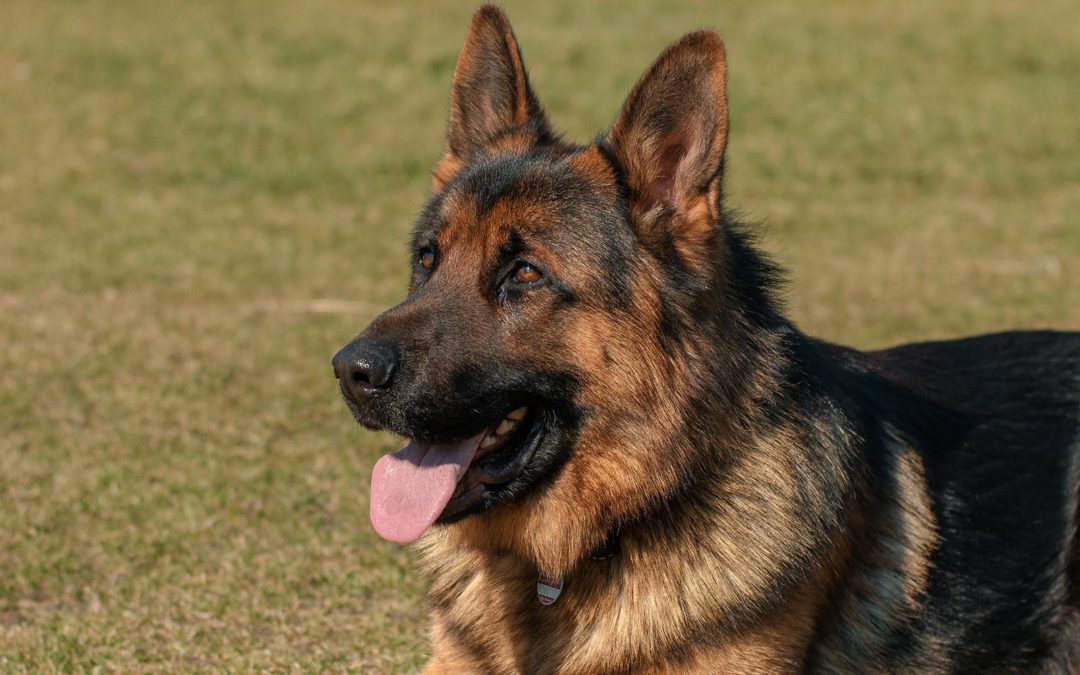According to the American Kennel Club, the German Shepherd has been the second most popular breed in America for many years running. People are attracted to the breed for their beautiful, powerful appearance and their wonderful temperaments. They are popular as family guardians, service dogs, and active companions. This breed is also probably the most common breed we see for Full-Service training, and we love all of the unique traits that make them so special.
This profile will examine the breed’s history, temperament traits, physical traits, and how these things pertain to our training. Understanding your dog’s needs is one of the first steps in developing a solid training program and ensuring that you are fulfilling your dog in their daily life.
Breed History
As you can probably guess by their name, the German Shepherd first originated in Germany. Max von Stephanitz is considered the father of the breed, and he is responsible for having created the first standards for the breeding of the German Shepherd. The first origins of the breed were in sheep herding, but their intelligence and work ethic led them to be used in many different disciplines. Since their creation, German Shepherds have been used widely for military work, search and rescue, delivering messages, protection work, guard dog duties, service and guide dog work, and sport dogs. In fact, the sport of IPO was created as a breed test for the German Shepherd and was used to evaluate dogs for suitability inbreeding.
The breed in the present day has several “splits.” Dogs bred for the show ring often do not have the drives that dogs bred for work do. Dogs from show lines can be identified by a more refined appearance and more extreme angulation, leading to the appearance of a sloping back. The working line dogs tend to have a more powerful appearance and will often be higher energy than their show line counterparts.
What Does This Mean for You?
Even though most German Shepherds live as pets today, they still need to have jobs in their daily lives. That doesn’t mean that you need to go out and take up search and rescue work, but it does mean that you need to challenge your dog mentally and physically regularly. Good obedience training is a nice outlet and has the added benefit of making your dog easier to live with daily. Other good outlets include regular games of retrieve and tug, nose work activities, and dog sports.
Many of today’s German Shepherds still maintain the breed traits that make them useful in working applications. Their strong defensive instinct means that many GSDs are wary of strangers, prone to barking, and reactive when on a leash or behind a barrier. They are also very handler-focused, and this leads many to develop separation anxiety. There are also some physical considerations to take into account when training your German Shepherd. Let’s examine each of these in-depth.
Sociability with Strangers
A common reason that people get a German Shepherd is as a deterrent and a guard dog. This is a role that they are well suited for but can also be challenging to balance in social situations. It is important to consider this when getting this breed, and you cannot treat one the same way you would treat a Lab or a Golden. Make sure that your German Shepherd puppy is well socialized with people in their socialization window of 8-16 weeks. If you note any fear, reactivity, or aggression during this time, get in touch with a professional trainer who can help provide guidance.
This is also where good obedience skills can come into play. The place command is important for all dogs but can be especially useful with working breeds. Whenever guests come over, rather than your dog’s job to guard the door, you can assign them a job of sitting on their bed. This allows the dog to still be part of the action without being right in the middle of things.
Excessive Barking and Whining
Many German Shepherd Dogs have quite an impressive vocal range and will freely share it with you and all of your neighbors. This trait means that they have to be managed and taught a system for controlling the barking. One method is to teach your dog a command that means, “Hey, thanks for letting me know someone is here, but your job is over, and I need you to stop barking.” We use the word “enough” around here to fill this purpose, and like any other command, we can provide a positive or negative consequence based on if our dog follows the command or not.
Leash Reactivity
Many people are under the impression that their dog is aggressive toward people or dogs because they act aggressively when on leashes. Sometimes this is true aggression, but other times it is simply reactivity that has been built through many instances of a dog getting scared or frustrated when on walks and lashing out because of this. The heel command is essential for dogs prone to this sort of thing, as it will eliminate several of the factors that cause this issue. It eliminates a tight leash, creates more handler focus, and allows the dog to process the environment clearly. If you are struggling with this issue, be sure to contact a trainer who has experience in this area.
Below is a video of Dakota, a young German Shepherd who came to training for exactly this issue.
Separation Anxiety
We joke with many of our German Shepherd clients that their dogs are Stage 5 Clingers. The breed is famed for their Rin Tin Tin level of loyalty and attachment to their owners. This trait makes them wonderful family members and can lead to stress when the dogs are separated from their people. Here is where that wonderful place command comes back into play. The place command and sit and down stays are healthy ways to build separation in a way that your dog doesn’t even realize is happening. Start with shorter distances and gradually build the difficulty. Good crate training is also important, and your dog needs to feel secure in his crate so that you can comfortably leave him there when you leave the house.
Physical Considerations
As with many large breed dogs, German Shepherds can suffer from orthopedic and joint issues. A common issue that we see with young German shepherds is a condition called Panosteitis, or Pano. This condition is basically the same as growing pains with people. It can cause a young dog to limp on and off while they have growth spurts. While this goes away once the dog is an adult, it means there may be times where you have to hold off on training for a few days when they are sore. The slow growth rate of the breed also means that you need to be careful with high-impact activities while your dog is young. Hold off on things like jogging and jumping until your vet says that your dog’s growth plates are closed, and they can safely do these activities.
Love Me, Love My GSD
The German Shepherd is a wonderful breed that holds a big spot in the hearts of millions worldwide. They give us endless loyalty, love, and companionship. In return, we owe it to them to give them the outlets and structure that they need. This article should give you a good idea of the kinds of things you can do to ensure that you are providing your German Shepherd with the best life possible.



